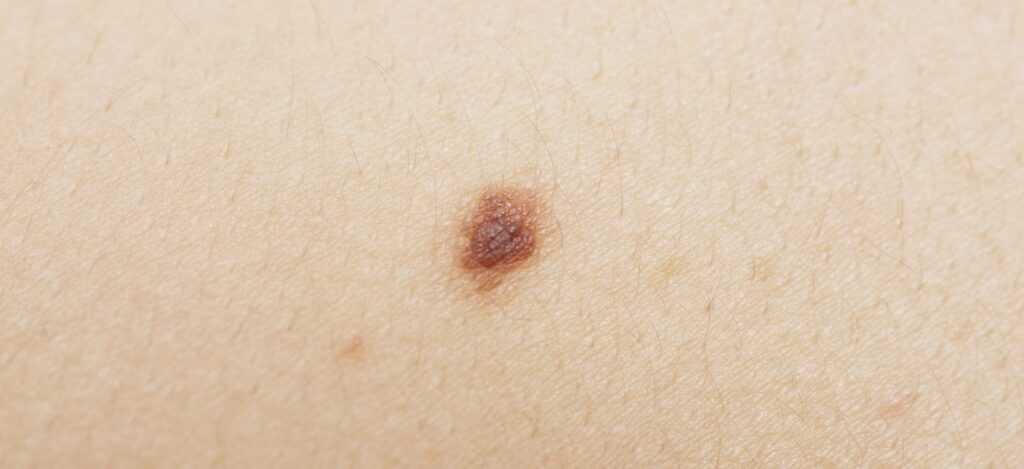Introduction
Birthmarks, including congenital nevi, are common skin features that appear in over 80% of all babies and can vary widely in appearance and size. While most congenital nevi are benign, some carry a risk of developing into skin cancer, particularly melanoma. This blog will explore the risks associated with congenital nevi, factors that influence these risks, and best practices for managing and monitoring them.
What is a Congenital Nevus?
A congenital nevus is a type of mole that is present at birth or appears shortly thereafter. These moles can vary in size from small to giant and may appear anywhere on the body. They are typically brown or black but can also be flesh-colored or exhibit hair growth.
Risk Factors for Skin Cancer in Congenital Nevi
Features Increasing the Risk
- Size: Larger congenital nevi, particularly those over 20 cm in diameter, carry a higher risk of becoming malignant.
- Location: Nevi located on the scalp or back, areas more prone to sun exposure, may have an increased risk.
- Depth and Texture: Nevi that are thicker or have an irregular surface can be more concerning.
- Color Variation: Nevi with multiple colors or uneven pigmentation warrant closer observation.
Greatest Risk Period
The risk of a congenital nevus becoming skin cancer is greatest during childhood and early adulthood. However, vigilance is essential throughout a person’s life, as the risk, while highest in younger years, does not disappear with age.
Impact of Age and Size
Age of the Patient
- Children and Adolescents: Younger patients with large congenital nevi are at a higher risk, emphasizing the need for early and regular dermatological evaluations.
- Adults: Although the risk decreases with age, adults with congenital nevi should still undergo regular skin checks to detect any changes early.
Size of the Nevus
- Small Congenital Nevi: Typically less than 1.5 cm, these carry a lower risk but still require periodic monitoring.
- Medium Congenital Nevi: Sized between 1.5 cm and 20 cm, these have a moderate risk.
- Large/Giant Congenital Nevi: Larger than 20 cm, these are at the highest risk for melanoma and need the most careful monitoring and consideration for removal.
Management of Congenital Nevi
Should All Congenital Nevi Be Removed?
Not all congenital nevi need to be removed. The decision depends on several factors:
- Risk Assessment: Dermatologists assess the nevus’s size, location, and appearance to determine the necessity of removal.
- Cosmetic Concerns: Some removals are based on cosmetic preferences or if the nevus is prone to irritation or injury.
Monitoring and Changes Over Time
If a congenital nevus is not removed, it should be closely monitored:
- Regular Dermatologist Visits: Annual or bi-annual check-ups are essential, especially for larger nevi.
- Self-Examinations: Patients should conduct monthly skin self-exams to notice any changes early.
Changes of Concern
Congenital nevi can change over time, and certain changes are particularly concerning for skin cancer:
- Increase in Size: Rapid growth or expansion of the nevus.
- Color Changes: Development of multiple colors or darkening of the nevus.
- Texture Changes: Becoming rough, bumpy, or developing an irregular surface.
- Bleeding or Ulceration: Any sign of bleeding, oozing, or the formation of sores.
- Asymmetry: Changes in shape, with one half not matching the other.
- Border Irregularity: Edges becoming ragged, notched, or blurred.
It is important to keep in mind that a mole often grows with the child. It is when the mole starts growing out of proportion to the child, or starts to display new or irregular features, attention should be sought.
When to Seek Help
A patient with a congenital nevus should seek the help of a dermatologist if:
- New Symptoms Appear: Any of the concerning changes listed above are noted.
- Annual Check-Ups: Regular professional evaluations are due, especially if the nevus is large.
- Peace of Mind: Any concerns or anxieties about the nevus should prompt a visit for reassurance and professional advice.
Relevant Medical Studies
Several medical studies have examined the relationship between congenital nevi and the development of skin cancer. Here are some key findings:
Study 1: Risk of Melanoma in Large Congenital Nevi
- Published in: Journal of the American Academy of Dermatology
- Findings: This study found that individuals with large congenital nevi (greater than 20 cm) have a significantly increased risk of developing melanoma. The risk was highest during the first decade of life but remained elevated throughout adulthood.
Study 2: Melanoma Risk in Small and Medium Congenital Nevi
- Published in: British Journal of Dermatology
- Findings: This research indicated that small and medium-sized congenital nevi also pose a risk for melanoma, though the risk is lower compared to large nevi. The study emphasized the importance of regular monitoring, particularly for medium-sized nevi.
Study 3: Congenital Nevi and Long-Term Melanoma Risk
- Published in: Dermatology
- Findings: A longitudinal study that followed patients with congenital nevi over several decades found that while the risk of melanoma is most pronounced in early life, there is a persistent, albeit lower, risk in later years. The study highlighted the need for lifelong vigilance.
In general, the risk of a congenital mole becoming cancerous is still quite low. The studies demonstrated the risk of small- and medium-sized moles becoming cancerous was likely less than 1%. For large moles, the risk was more varied but is still likely less than 5%, on average.
Conclusion
Congenital nevi are generally benign but carry varying risks of developing into melanoma based on their size, location, and other characteristics. Early and regular monitoring by both patients and dermatologists is crucial in managing these birthmarks. Removal decisions should be based on a thorough risk assessment and personal preferences. By staying vigilant and proactive, individuals with congenital nevi can significantly reduce their risk of skin cancer and ensure early detection and treatment if necessary.
If you are concerned about your child’s mole or birthmark, please contact Dr. Mamelak and the Austin Mohs Surgery Center today.

